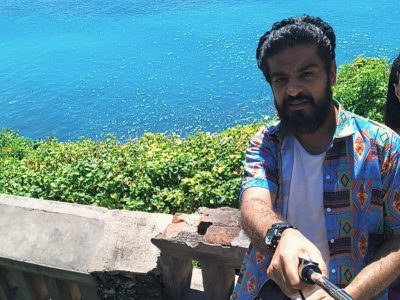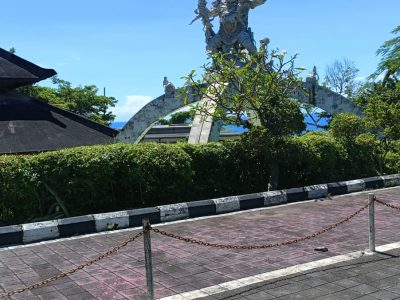About Uluwatu Temple
About Uluwatu Temple-
Uluwatu Temple, also known as Pura Luhur Uluwatu, is a Balinese Hindu temple on the southwestern tip of Bali’s Bukit Peninsula. The temple is perched on a rocky cliff about 70 meters above the Indian Ocean, providing a stunning view of the ocean and sunset.
The temple is one of six main temples considered to be Bali’s spiritual pillars. It was built in the 11th century and restored in the 16th century by Javanese Hindu guru Empu Kuturan.
There are several minor temples, a Balinese gate, and a large courtyard in the temple complex. The inner sanctum of the temple is located on the cliff’s edge and is only accessible to Hindu devotees. Visitors to the temple must wear sarongs and sashes, which are available at the entry.
Apart from its religious significance, Uluwatu Temple is well-known for its evening kecak dance performances. The dance tells the Ramayana story and is done by a group of about 50 men who chant “cak” while acting out the story.
Many travelers flock to Uluwatu to watch the sunset and take in the breathtaking views of the ocean and the temple. Visitors should be advised, however, that the area may be rather crowded, and they should use caution around monkeys, which can be aggressive and steal food and personal things.
History timeline of Uluwatu Temple
Here is a timeline of the history of Uluwatu Temple:
- 11th century: The original Uluwatu Temple is believed to have been built during the reign of the Warmadewa dynasty, one of Bali’s earliest ruling dynasties.
- 16th century: The temple is rebuilt by the Javanese Hindu sage, Empu Kuturan, during the reign of the Majapahit Empire.
- 1900s: The Dutch colonial government carries out restoration work on the temple.
- 1983: The temple is damaged by a strong earthquake, but is later restored.
- 1999: A fire breaks out in the temple, destroying some parts of the complex, including the wooden bell tower.
- 2010: The temple undergoes a major renovation project, which includes the construction of a new parking area, a wider road leading to the temple, and the restoration of several structures within the temple complex.
Statistics of Uluwatu Temple
Here are some general statistics about the temple:
- Location of Uluwatu Temple: Uluwatu Temple is located on the southwestern tip of the Bukit Peninsula in Bali, Indonesia.
- Elevation of Uluwatu Temple: The temple is situated on a steep cliff about 70 meters above the Indian Ocean.
- Age of Uluwatu Temple: The original temple is believed to have been built in the 11th century, while the current structure dates back to the 16th century.
- Size of Uluwatu Temple: The temple complex covers an area of about 10 hectares and includes several small temples, a Balinese gate, and a spacious courtyard.
- Visitors of Uluwatu Temple: Uluwatu Temple is a popular tourist destination and attracts thousands of visitors each year, both domestic and international.
- Kecak Dance in of Uluwatu Temple: The temple is famous for its nightly kecak dance performances, which are attended by large crowds of tourists.
- Religion: Uluwatu Temple is a Balinese Hindu temple and is considered one of the six key temples believed to be Bali’s spiritual pillars. It continues to be an important spiritual site for Balinese Hindus.
Also read – Checklist to travel to Bali
List of Hotels near Uluwatu temple
Here are some hotels near Uluwatu Temple in Bali, Indonesia:
- Anantara Uluwatu Bali Resort
- Bulgari Resort Bali
- Blue Point Bay Villas & Spa Hotel
- Renaissance Bali Uluwatu Resort & Spa
- Uluwatu Surf Villas
- Alila Villas Uluwatu
- Wyndham Dreamland Resort Bali
- Uluwatu Breeze Village
- Suarga Padang Padang
- Radisson Blu Bali Uluwatu
List of Beaches near Uluwatu Temple
List of Beaches around Uluwatu temple –
- Padang Padang Beach – This beach is located about 3.5 km north of Uluwatu Temple and is known for its clear waters, white sand, and surfing opportunities.
- Bingin Beach – Located about 4.5 km northwest of Uluwatu Temple, Bingin Beach is a popular spot for surfing and relaxing on the beach.
- Dreamland Beach – This beach is located about 5 km northwest of Uluwatu Temple and is known for its wide sandy beach and clear waters.
- Balangan Beach – Located about 6 km north of Uluwatu Temple, Balangan Beach is a quiet, secluded beach with turquoise waters and a picturesque landscape.
- Suluban Beach – Also known as Blue Point Beach, Suluban Beach is located about 7 km northwest of Uluwatu Temple and is known for its stunning cliff formations, hidden caves, and great surfing waves.











Comment (0)